-
Paper Information
- Previous Paper
- Paper Submission
-
Journal Information
- About This Journal
- Editorial Board
- Current Issue
- Archive
- Author Guidelines
- Contact Us
World Environment
p-ISSN: 2163-1573 e-ISSN: 2163-1581
2013; 3(3): 116-125
doi:10.5923/j.env.20130303.07
Climate Change Impacts on Shrimp Production at the South-West Coastal Region of Bangladesh
Ruksana H. Rimi1, Shazia Farzana1, Md. S. Sheikh1, Md. Z. Abedin2, Arjun C. Bhowmick3
1Department of Environmental Science and Resource Management, Mawlana Bhashani Science and Technology University, Santosh, Tangail, 1902, Bangladesh
2United Nations Development Programme (UNDP), Agargaon, Dhaka, Bangladesh
3Department of Chemistry, Mawlana Bhashani Science and Technology University, Santosh, Tangail, 1902, Bangladesh
Correspondence to: Ruksana H. Rimi, Department of Environmental Science and Resource Management, Mawlana Bhashani Science and Technology University, Santosh, Tangail, 1902, Bangladesh.
| Email: |  |
Copyright © 2012 Scientific & Academic Publishing. All Rights Reserved.
This study was conducted to investigate the changes ofclimate, salinity and their consequent impacts on shrimp production at Shyamnagar under Satkhira District, Bangladesh. An integrated technique was used including social survey, historical climate data, shrimp production data and field analysis. During 1980-2009, a statistically significant decreasing trend of annual average maximum temperature but increasing trend of annual average minimum temperature was found. Maximum temperature exhibited significant decreasing trend in post-monsoon while, increasing trend in winter. The trend of minimum temperature was increasing significantly in post monsoon. Significant increase in relative humidity trends were found in all seasons. Salinity levels of the shrimp farm waters were found to exceed the threshold limits for proper shrimp production. Although the total production was increasing, the rate of shrimp production was decreasing relative to total area of farms. No statistically significant relationships were found between the annual shrimp production and climatic parameters or salinity levels. Depths of inundation at monsoon season exceeded 180 cm, on contrary, at dry season less than 30 cm which was not proper for shrimps. The surface water salinity ranged from 7-46 ppt making farm waters unsuitable for shrimp production. According to the GM (1,1) model, the production of shrimp was hampered by climatic hazards, increasing inundations and salinity problems.
Keywords: Climate Change, Salinity, Shrimp Production
Cite this paper: Ruksana H. Rimi, Shazia Farzana, Md. S. Sheikh, Md. Z. Abedin, Arjun C. Bhowmick, Climate Change Impacts on Shrimp Production at the South-West Coastal Region of Bangladesh, World Environment, Vol. 3 No. 3, 2013, pp. 116-125. doi: 10.5923/j.env.20130303.07.
Article Outline
1. Introduction
- Bangladesh is one of the most vulnerable countries to climate change in the world, where climate change has been projected to impact broadly across ecosystems, increasing pressure on all livelihoods and food supplies, including fisheries and aquaculture sector. Climate change has a great influence on aquaculture, agriculture, and fisheries sectors in developing countries that create pressure on its’ food security and on livelihood[1]. Fisheries are the second largest sector by which Bangladesh earns its revenue and particularly the shrimp culture claims an important part of this sector. Bangladesh is the 9th (1.5%) top aquaculture producers in the world[2]. Shrimp farming has taken place mainly on the reclaimed mangrove forest at the Sundarban region at Shyamnagar Upazila of Satkhira District from where the lion share of the shrimp production of Bangladesh come. Different studies established that Indian sub-continent is facing decreasing rainfall while trend of surfacetemperature is increasing[3,4,5,6]. In the Indian sub-continent, annual mean temperature could increase in the range between 3.5 and 5.5ºC by 2080s[7]. Many among these studies shown that Bangladesh is experiencing scorching heat during summer and severe cold in winter as a result of climate change with an increase in the frequency and intensity of heavy rainfall during rainy season. Climate change impacts on shrimp culture could occur either directly or indirectly and in case of many aquaculture practices, one single factor of climate change cannot be certified[8]. Depletion of dissolve oxygen especially in the summer months when water exchange becomes very difficult in the shrimp ponds, salinity decrease[9], and algal blooms can seriously impact on farm productions[10]. In aquaculture, high temperatures could also increase intensity and frequency of disease outbreaks of shrimp and adversely impact on water quality in source water bodies[11,12,13]. Infrastructures of shrimp pond and shrimp stocks are damaged by increasing intensity and frequency of extreme climatic events[14,15]. Furthermore, after extreme climatic events, their negative impacts on aquaculture also contribute to changes in salinity of pond water, disease outbreak, invasion of predators along with flooded water[10]. In certain geographical locations, sea level rise and tidal surge lead to frequently inundation of coastal lands that can reduce availability of brackish water aquaculture area and lead to loss of shrimp stocks[16]. Shrimp was the mainstay of Bangladesh seafood exports as the nation ranks as one of the largest producers of the black tiger species Penaeus monodon. Fish physiology like growth, reproduction and activity are directly influenced by the changes of temperature [17]. The main impacts of climate change on the coastal areas in Bangladesh are sea level rising, freshwater availability reduction by salinity intrusion and increasing cyclone frequency[18]. According to Jekobsen et. al.[19], Faisal and Parveen[20], Alam[21], IPCC[22] and World Bank[23], water salinity and its distribution in the coastal areas of Bangladesh are increasing with sea level rise. The present study tried to provide the key information about changes in climate at Satkhira district and its impacts on shrimp production at Shyamnagar Upazila. Satkhira District was taken as a study area because this is the second largest shrimp farming area in Bangladesh and also, the west coast (Shyamnagar Upazila is the frontline of the coast) of Bangladesh is subject to frequent cyclonic storms and occasional tidal waves which cause loss of aquaculture stock and damage to aquaculture facilities. There is a need to estimate the likely effects of climate change on the shrimp aquaculture sector and to develop strategies to assist farmers and rural communities to adapt with the upcoming changes.
2. Methodology
2.1. Background of the Study Area
- Shyamnagar Upazila (Fig. 1) under the Satkhira District, is in the front foot of South-west coastal region of the country with an area of 1968.24 km2, and is one of the largest Sub-districts of Bangladesh. Shyamnagar Upazila is bounded by Kaliganj and Assasuni upazilas on the north, Sundarbans and Bay of Bengal on the south, Koyra and Assasuni upazilas on the east, West Bengal of India on the west. Main rivers are Raymangal, Kalindi, Kobadak, Mother Kholpetua, Arpangachia, Malancha Hariabhanga and Chuna.
2.2. Data Collection
- Secondary information of climatic data such as temperature, rainfall and humidity during 1980-2009, shrimp production data from 2000 to 2010, and salinity data of farm water during 2000-2011 was collected from Meteorology Department, Fisheries Department and Bangladesh Agricultural Development Corporation (BADC), Soil Resource Development Institute (SRDI), respectively.
2.3. Data Analysis
- Five years moving annual averages of maximum and minimum temperature, rainfall and humidity data have been analyzed to recognize the trends during 1980-2009. Again, five year moving maximum temperature, minimum temperature, rainfall and humidity data have been analyzed seasonally dividing them into pre-monsoon (March-May), monsoon (June-Sept), post-monsoon (Oct-Nov) and winter (Dec-Feb) seasons to understand the trends of seasonal variation of climatic parameters during 1980-2009. Afterwards, the correlations between shrimp production and salinity, maximum temperature, minimum temperature, rainfall and humidity have been made. Moreover, GM (1,1) model was used for the future production prediction for the study area.
3. Results and Discussion
3.1. Trend of Climate Change
3.1.1. Temperature and Rainfall in Satkhira District
- The study found that in the Satkhira district, the five year moving average of maximum temperature (°C) during 1980-2009 was decreasing (R2=0.5002) but minimum temperature (°C) was increasing (R2=0.5103) significantly (Fig. 2). The total rainfall (mm) was increasing (R2=0.3705) insignificantly (Fig. 3) at the district.
3.1.2. Seasonal Variation of Maximum Temperature at Satkhira District
- The study found that the five years moving average of maximum temperature in Pre-monsoon and monsoon season was decreasing (R2=0.217 and R2=0.2159) insignificantly (Fig. 4). In post-monsoon season the maximum temperature was decreasing significantly (R2=0.7374), but it was increasing (R2=0.5103) significantly in winter (Fig. 5).
 | Figure 1. Study area of Satkhira district and Shyamnagar Upazila in Bangladesh. (Source: Banglapedia, 2006) |
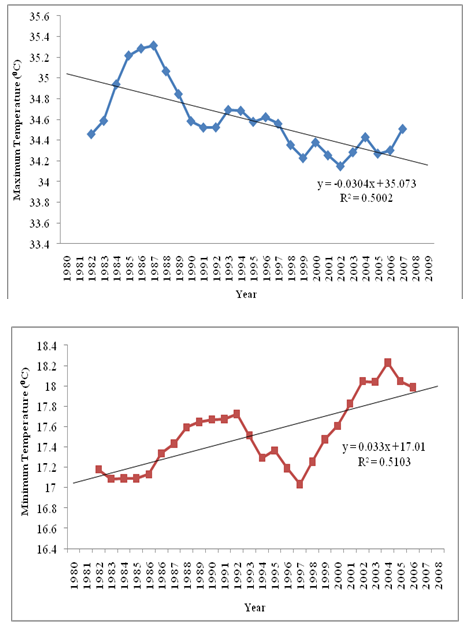 | Figure 2. Trends of maximum and minimum Temperature at Satkhira District |
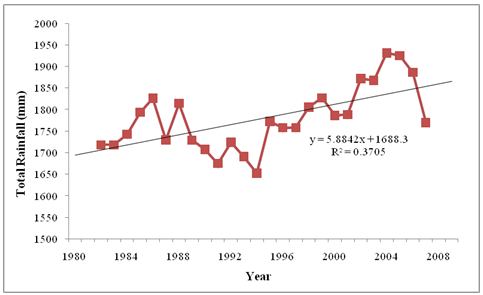 | Figure 3. Trend of annual total Rainfall at Satkhira District |
 | Figure 4. Five year moving average of maximum Temperature at Pre-monsoon and Monsoon |
 | Figure 5. Five year moving average of maximum Temperature at Post-monsoon and Winter season |
3.1.3. Seasonal Variation of Minimum Temperature at Satkhira District
- The study found that the trend of five years moving average of minimum temperature was increasing insignificantly at Pre-monsoon (R2=0.0653) and Monsoon (R2=0.3803) (Fig. 6). The trend minimum temperature was increasing significantly (R2=0.776) only in the post monsoon, and increasing insignificantly at winter season (R2=0.0372) (Fig. 7).
 | Figure 6. Five year moving average of minimum Temperature in Pre-monsoon and Monsoon |
 | Figure 7. Five year moving average of minimum Temperature in Post-monsoon and Winter season |
3.1.4. Seasonal Total Rainfall
- The trend of five years moving average of total rainfall was increasing which is statistically insignificant (R2=0.281 and 0.219) in Pre-monsoon and Monsoon period (Fig. 8). The trend of five years moving average of total rainfall was increasing significantly in Post-monsoon (R2=0.57) but in the Winter season its trend was very insignificant (R2= 0.0018) to recognize (Fig. 9).
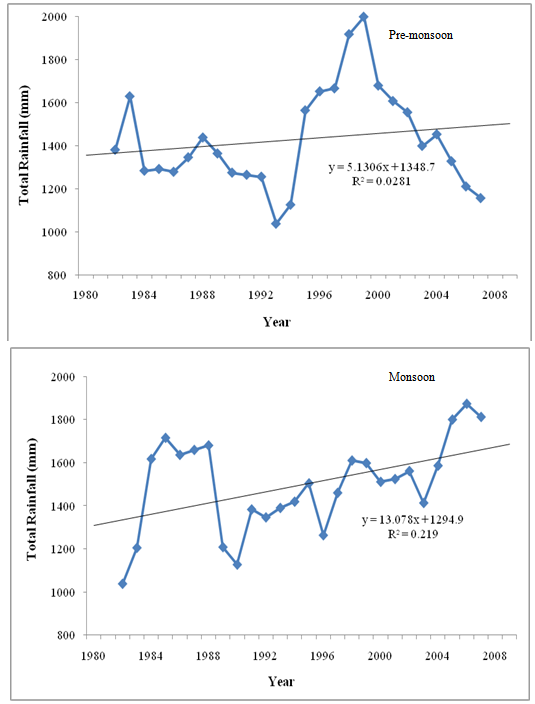 | Figure 8. Five year moving average total rainfall (mm) at Pre-monsoon and Monsoon |
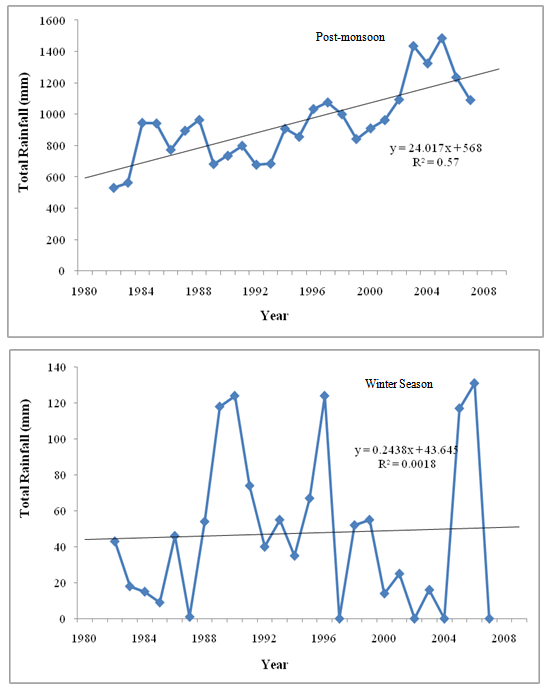 | Figure 9. Five year moving total Rainfall (mm) at Post-monsoon and Winter |
3.1.5. Seasonal variation of Humidity
- The five year moving average Relative Humidity (RH) was increasing significantly in all seasons. The trends of RH were associated with R2=0.615 in Pre-monsoon, R2=0.502 in Monsoon (Fig. 10), R2=0.762 in post-monsoon and R2=0.716 in Winter season (Fig. 11). Strongest increase in RH could be found following heavy rainfall in monsoon during post-monsoon season. Even in winter the RH was found to have strong increasing trend which might be attributed to the coastal climate environment.
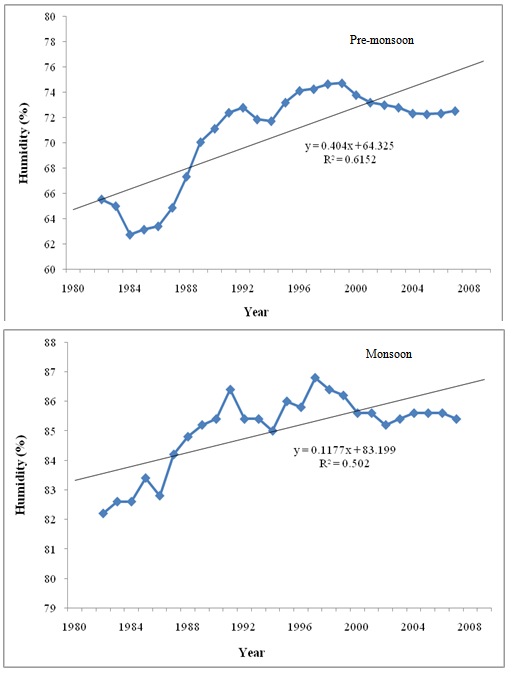 | Figure 10. Five year moving average RH (%) in Pre-monsoon and Monsoon period |
 | Figure 11. Five year moving average RH at Post-monsoon and Winter period |
3.2. Salinity Level of Shrimp Farm Water in Shyamnagar
- Both of the highest and lowest salinity levels in the shrimp farm waters have been increasing (Fig. 12). Statistically the trend of highest salinity exhibited significantly increasing with the nature (R2=0.5614) while in case of lowest salinity levels, it was insignificant (R2=0.3211). Although for the Golda Shrimp, required salinity level is <5 ppt and for Bagda Shrimp 15-25 ppt; the highest salinity at the study area was found during April to July ranging from 19 to 40 ppt, and lowest salinity was found during August to October ranging from 7 to 28 ppt. As a consequence, the salinity condition was found to become gradually unsuitable for Shrimp production.
 | Figure 12. Salinity levels of Shrimp farm water at Shyamnagar in Satkhira district |
3.3. Status of Shrimp Production in Satkhira District
- The study found that although the area and number of farms were increasing, total shrimp production was decreasing compare to area and number. For example, in 2006-2007 production was 18,796.12 MT where area was 52,356.89 hac, whereas in 2007-2008 area was increased to 53508.75 hac. but production was as same as before. The trend of shrimp production for the period of 2000-2010 (Fig. 13) exhibited an insignificant increasing trend (R2=0.309).
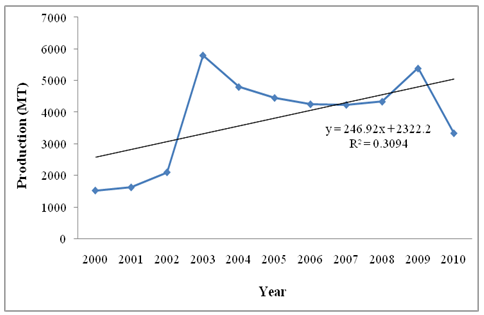 | Figure 13. Trend of Shrimp production in Shyamnagar, Satkhira |
3.4. Correlation of Shrimp Production with Climatic Parameters and Salinity
- The annual shrimp production and average maximum temperature during 2001-2010 was positively correlated but it was statistically insignificant (Fig. 14). Similarly, average minimum temperature for the same period had no significant direct relationship with the production (Fig. 14). The annual shrimp production was found to be negatively correlated with average rainfall, and positively correlated with average relative humidity but both were statistically insignificant (Fig. 15). A positive correlation was found for annual shrimp production and mean annual salinity which was also statistically insignificant (Fig. 16).
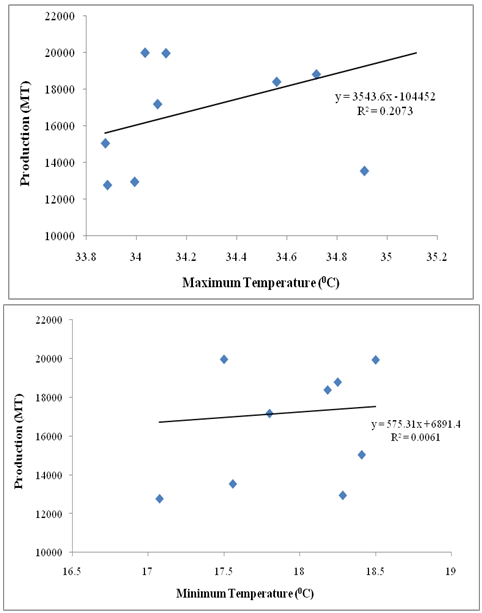 | Figure 14. Correlation of shrimp production with maximum and minimum Temperature (℃) |
 | Figure 15. Correlation of shrimp production with Rainfall (mm) and RH (%) |
 | Figure 16. Correlation of shrimp production with average Salinity |
3.5. Suitability Model for Shrimp Culture
|
3.6. Prediction of Shrimp Production by GM (1,1) Model in Satkhira District
- The comparison of actual value and predicted value of shrimp production by GM (1,1) model in the Satkhira District is shown in Fig. 17. The mean relative percentage error (MRPE) is 28% during 2000-2010. The predicted figure shows that there is a smooth growth curve for production. Even though statistically insignificant, the production of shrimp at this region is influenced by increasing climatic hazards and salinity.
 | Figure 17. Prediction of shrimp production in Satkhira District by using GM (1,1) prediction model |
4. Conclusions
- Natural resource (including world largest mangrove forest, Sundarbans), water, soil, agriculture, fisheries,socio-economic conditions, etc in Shyamnagar was affected by climate change and its associated impacts such as salinity increasing, cyclone, tidal flooding, water congestion, salinity intrusion, etc. The level of salinity is gradually increasing with the start of dry season which is raised at highest level in April-May-June, thus seriously hampered shrimp production in this region. Finally, it is clearly concluded from the study that climate was found at changing trend with increasing minimum temperature and humidity and rainfall, and decreasing maximum temperature in Satkhira District. The level of salinity is increasing exponentially. Although the total production was increasing, but the rate of shrimp production was decreasing compare with area and number of shrimp farm. According to the suitability model, the land is turning unsuitable for shrimp production because of increasing salinity and inundation by coastal flooding.
 Abstract
Abstract Reference
Reference Full-Text PDF
Full-Text PDF Full-text HTML
Full-text HTML